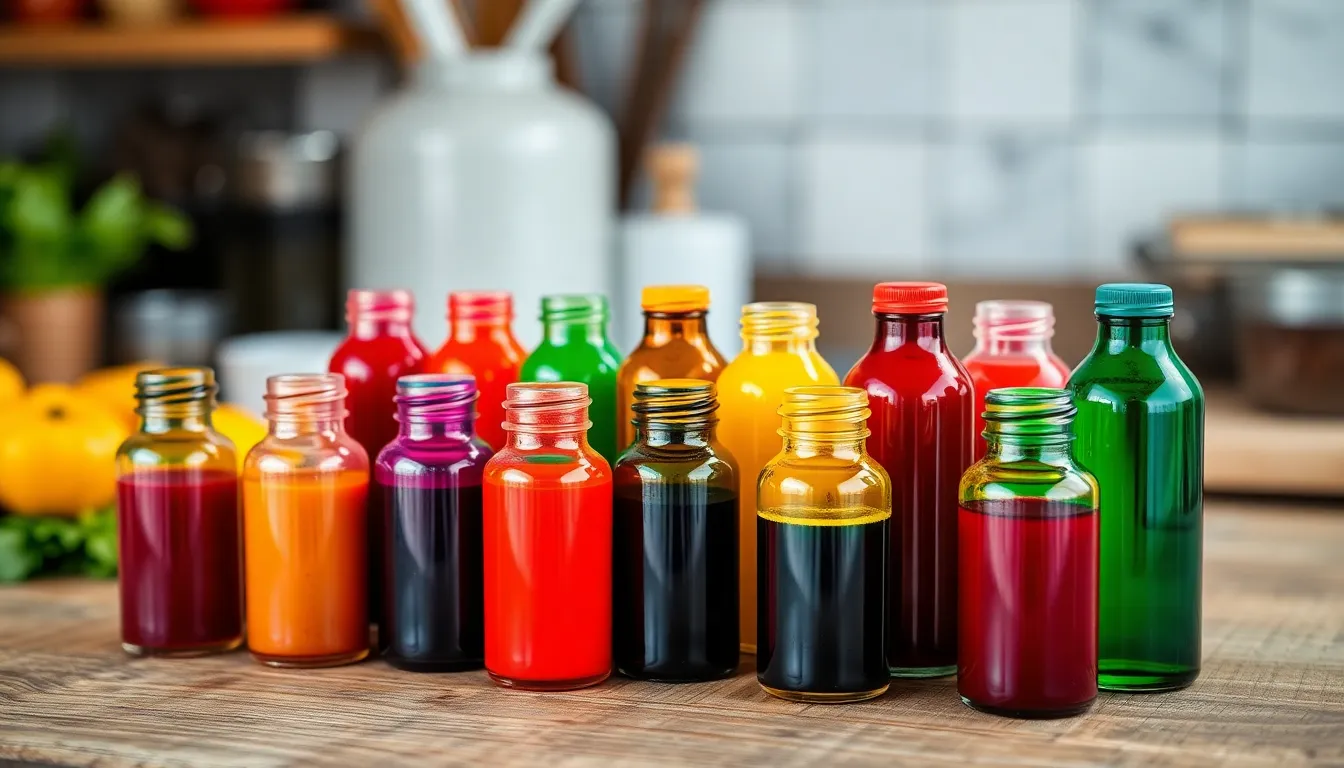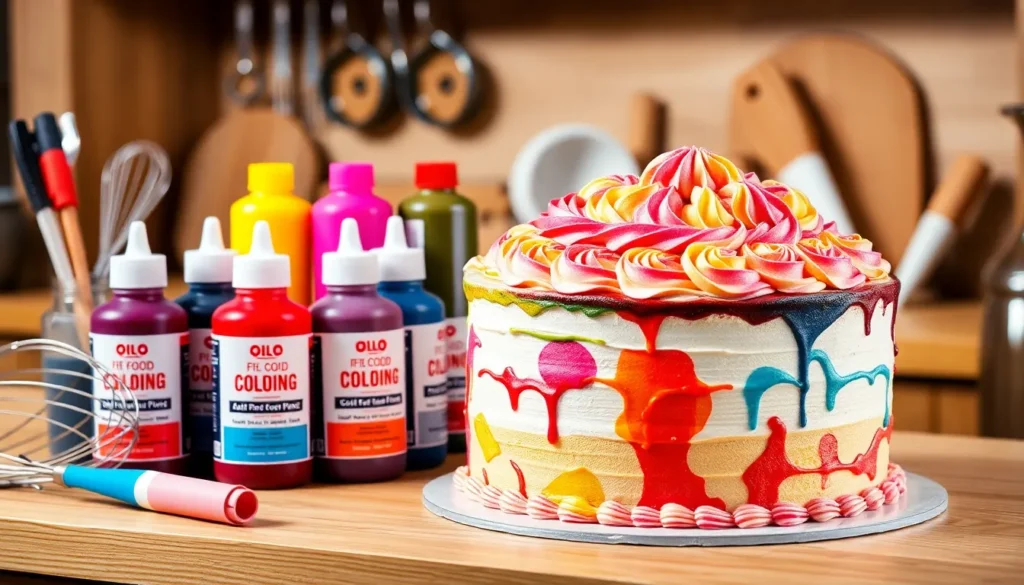In the vibrant world of culinary arts, oil food coloring stands out as a versatile tool for chefs and home bakers alike. Unlike traditional water-based colors, oil food coloring offers a unique ability to blend seamlessly into various fats and oils, making it ideal for chocolates, frostings, and even savory dishes. This innovation not only enhances visual appeal but also allows for creative expression in food presentation.
As more people seek to elevate their culinary creations, understanding oil food coloring’s benefits and applications becomes essential. With a wide range of shades available, it empowers cooks to transform ordinary dishes into stunning masterpieces. Whether it’s for a special occasion or everyday baking, mastering this coloring technique can take culinary skills to the next level.
Oil Food Coloring
Oil food coloring consists of concentrated colorants that blend effortlessly with oils and fats. Unlike water-based colorants, oil food coloring features lipophilic properties, allowing it to mix seamlessly into high-fat recipes. This type of coloring provides vibrant hues without compromising texture or flavor, making it ideal for various culinary applications.
Oil food coloring finds extensive use in products such as chocolates and ganaches. Chefs prefer these colors for frostings and icings that require a rich, opaque finish. It enhances the visual aspect of baked goods, offering bakers the opportunity to create intricate designs and striking presentations. Using oil food coloring in savory dishes also elevates the overall aesthetic, transforming mundane meals into visually stunning creations.
Oil food coloring is available in various forms, including gels, pastes, and liquids. Gels and pastes offer high pigment concentrations, allowing for easy color adjustments with small quantities. Liquid oil food coloring provides convenience for mixing into larger batches. Chefs and home bakers can mix different shades to customize their desired colors, enhancing creative freedom in numerous recipes.
While oil food coloring is safe for consumption, it’s essential to use it sparingly. A little goes a long way; excessive amounts may alter the flavor and texture of dishes. The correct use of oil food coloring not only boosts visual appeal but also allows culinary enthusiasts to push the boundaries of their creative expression in the kitchen.
Types of Oil Food Coloring

Oil food coloring comes in two main types: natural and artificial. Each type offers unique properties and applications for culinary use.
Natural Oil Food Coloring
Natural oil food coloring derives from plant or animal sources. Common sources include fruits, vegetables, and spices such as beet juice, turmeric, and spirulina. These colorants provide a range of shades, from pale yellows to deep reds, without synthetic additives. Natural options may have subtle flavors, enhancing the overall taste of dishes while coloring them. They appeal to health-conscious chefs and consumers seeking organic ingredients for their recipes. However, natural oil food coloring may not achieve the same vibrancy as synthetic alternatives, which can limit their use in certain applications.
Artificial Oil Food Coloring
Artificial oil food coloring consists of synthetic dyes designed for stability and brightness. These colorants offer a wider range of vivid colors and are often more concentrated than natural options. Products like Red 40 and Yellow 5 provide bold hues ideal for colorful frostings and confections. Artificial oil food coloring blends easily with various fats and oils, ensuring smooth integration into recipes. While effective in creating striking presentations, these colorants may raise concerns about artificial ingredients among some consumers. They are commonly used in commercial food production due to their consistency and strong pigmentation.
Uses of Oil Food Coloring
Oil food coloring serves various purposes across culinary and creative fields. Its versatility makes it a valuable ingredient for enhancing both aesthetics and flavor.
Baking and Cooking
Baking benefits from oil food coloring through the creation of vibrant cakes, cookies, and pastries. Oil-based colors blend seamlessly into batters and doughs, ensuring an even distribution of color. They withstand high temperatures, maintaining hue fidelity during baking. Chefs often use these colors in frostings and fillings, achieving striking visual appeal. Additionally, oil food coloring enhances savory dishes like pasta sauces and dressings, adding an eye-catching element to meals without altering taste.
Candy Making
Candy making utilizes oil food coloring to produce eye-catching confections. These colors blend effortlessly with chocolates and sugar-based candies, yielding rich, vivid shades. They ensure the desired visual impact while preserving texture and flavor. Oil food coloring is particularly effective for coating truffles and creating layered desserts. By mixing colors, candy makers achieve custom shades, enchanting customers with attractive designs.
Art and Crafts
Art and crafts leverage oil food coloring for various creative projects. Its versatility extends beyond food, allowing for unique designs in soap making, candle crafting, and painting. Oil-based colors mix with other art mediums, creating bold, lasting effects. Crafters appreciate how these colors deliver robust hues that maintain vibrancy over time. They can be applied to surfaces or blended with oils for mesmerizing artistic expressions.
Benefits of Oil Food Coloring
Oil food coloring provides multiple benefits that enhance culinary and creative applications.
- Versatility in Use: Oil food coloring blends effectively with fats and oils. Its compatibility with chocolates, frostings, and savory dishes allows for broader culinary creativity. Chefs and home bakers appreciate its adaptability in various recipes.
- Enhanced Visual Appeal: Oil food coloring delivers vibrant hues that elevate the presentation of food. It transforms simple dishes into visually stunning creations while maintaining compatibility with ingredients.
- Smooth Mixing: The lipophilic properties of oil food coloring enable seamless integration into high-fat recipes. This quality ensures no compromise on texture or flavor, making it an ideal choice for products like ganaches and confectionery.
- Creative Freedom: Available in gels, pastes, and liquids, oil food coloring offers flexibility in customization. Culinary enthusiasts can mix shades to achieve desired effects, allowing for individual artistic expression in dessert and dish presentation.
- Safe Consumption: Both natural and artificial oil food colorings are safe for consumption. They provide options for health-conscious consumers, with natural colorings sourced from plants and animals, while artificial variants deliver more intense colors.
- Longevity of Color: Oil food coloring retains its vibrancy during baking processes. Its ability to withstand heat ensures that the intended shades remain after cooking, making it a dependable choice for baked goods.
- Non-Altering Flavor Profile: While enhancing appearance, oil food coloring does not alter the flavor of dishes when used correctly. Moderation maintains the balance of taste and aesthetics, resulting in appealing culinary outcomes.
Oil food coloring supports diverse applications, empowers creativity, and enhances the overall culinary experience.
Tips for Using Oil Food Coloring
- Choose the Right Type: Select between natural and artificial oil food coloring based on desired vibrancy and ingredient preferences. Natural options provide subtle shades, while artificial colorants yield bold, vivid colors.
- Mix Thoroughly: Ensure complete incorporation by mixing oil food coloring into fats and oils before adding other ingredients. This promotes an even distribution of color throughout the mixture.
- Use Sparingly: Apply oil food coloring in small amounts, gradually increasing until achieving the desired hue. Excessive use can alter the flavor or texture of recipes.
- Test Colors First: Experiment on a small scale by testing colors in a small batch. This helps in determining how the final product will appear after baking or cooling.
- Consider Temperature: Maintain room temperature when using oil food coloring in chocolate and ganache. Elevated temperatures can affect the mixing process and color retention.
- Pair with Compatible Ingredients: Combine oil food coloring with high-fat ingredients for best results. It performs excellently in chocolates, frostings, and savory dishes.
- Store Properly: Keep oil food coloring in a cool, dark place to prolong shelf life. Avoid exposure to direct sunlight or heat sources.
- Know the Application Technique: Use a toothpick or small dropper for precise application when adding color to small portions, preventing over-saturation.
- Blend for Custom Shades: Mix different colors to create custom shades. Start with primary colors, and adjust ratios until achieving the perfect tone.
- Check Labels: Read product labels for specific usage instructions and recommendations. Following manufacturer guidelines ensures optimal results.
Conclusion
Oil food coloring stands out as an essential tool for enhancing the visual appeal of culinary creations. Its ability to blend seamlessly with fats and oils opens up a world of possibilities for both professional chefs and home bakers. By choosing between natural and artificial options, users can tailor their color choices to suit their needs and preferences.
With proper usage techniques, oil food coloring can elevate dishes without compromising flavor or texture. Whether it’s for vibrant cakes, eye-catching chocolates, or artistic projects, this versatile ingredient empowers creativity in the kitchen and beyond. Embracing oil food coloring can truly transform ordinary meals into extraordinary visual experiences.

